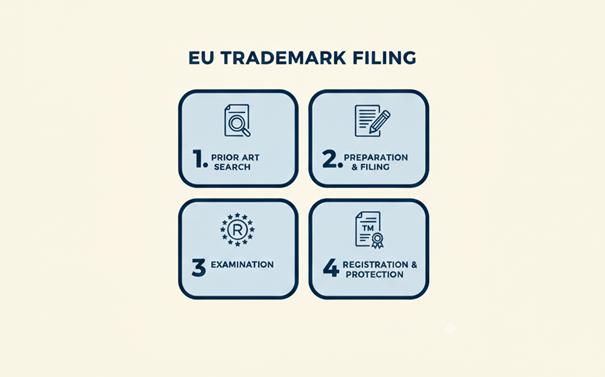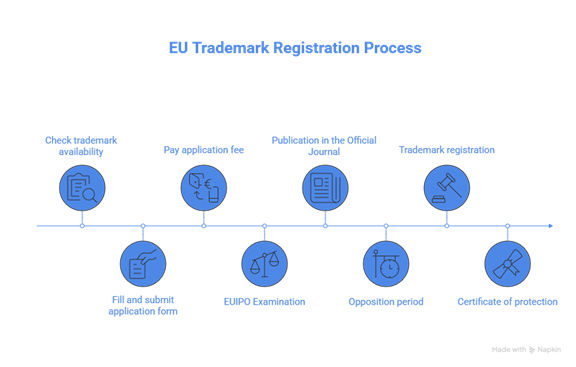Sommaire
Introduction
Trademarks are a key intellectual property asset for companies of all sizes. They enable you to differentiate your products and services from those of competitors and provide legal protection allowing you to defend your protected names and logos. If you are considering filing a trademark benefiting from protection throughout the European Union (EU), this article briefly explains the different steps to follow.
Step 1: Prior art search
The first step is to verify the availability of the trademark you wish to file. Before any filing, it is essential to carry out a “prior rights search” to ensure that the name or logo you wish to protect is not already registered by a third party for identical or similar products or services. This approach helps to prevent the risk of future legal conflicts.
At first, the EUIPO’s trademark search tool is a good starting point to obtain an initial indication of any identical prior rights, both among EU trademarks and national trademarks of the various EU member states.
For an EU trademark project, it is generally essential to carry out a more in-depth search. This can be done with the assistance of an intellectual property attorney who has access to specialized tools and the expertise necessary to identify not only identical but also similar trademarks that basic identity searches may miss.
If no blocking prior rights are detected, you can then move confidently to the next step of the filing process.
Step 2: Filing of the trademark
The second step is to complete a trademark application form. This form must include several pieces of information: the name of the trademark and/or logo, the name of the company that will own the trademark, its contact details, and the classes of the goods and services covered. Drafting the specification of goods and services should be done with the assistance of an attorney. Once the form is completed and submitted, you must pay a so-called “filing” fee.
Step 3: Examination of the trademark application
The third step is no longer under your control. Once the trademark application has been submitted to the EUIPO, it will undergo a rapid examination of the substantive and formal conditions that every trademark application must meet, including notably:
- Are the goods and/or services for which your trademark is filed correctly classified?
- Has the application been correctly completed?
- Has the fee been paid?
Please note: the EUIPO does not carry out a prior check of your trademark’s availability in relation to trademarks already registered in the European Union. However, it informs holders of earlier rights when a trademark application appears similar to their rights.
After this examination, the EUIPO will publish your trademark application in the Official Journal of the European Union. This informs third parties of your filing. From the date of publication, third parties have three months to oppose the registration of the trademark if they believe it infringes their own rights.
Step 4: Trademark registration
At the end of the examination process, the trademark is either accepted or refused for registration. If accepted, you will receive a digital registration certificate. This certificate provides proof of the legal protection granted to your trademark in the EU.
Finally, keep in mind that the EU trademark is protected for 10 years and is indefinitely renewable at the end of the initial protection period. A renewal fee must be paid to extend the protection for a new 10-year period.
Conclusion
To register a trademark in the EU and maintain its protection, each of these steps must be followed. The prior rights search is an essential prerequisite as it helps ensure, as far as possible, that no opposition will be filed after your trademark application.
Dreyfus & Associés can assist you at every stage of your trademark filing, from the prior rights search to its official registration, to secure your rights effectively.
Nathalie Dreyfus with the support of the entire Dreyfus team
FAQ
1. What is an EU trademark and what are its advantages?
An EU trademark (EUTM) is a single title granted by the EUIPO which provides uniform protection in all 27 Member States. It simplifies and centralizes the filing, management and enforcement of your rights in the EU.
2. How much does it cost to file an EU trademark?
Official fees start at €850 for one class of goods or services. Additional fees apply for each extra class. Attorney’s fees are charged separately.
3. Is it better to file a national trademark or an EU trademark?
This depends on your objectives and geographic scope. Filing a national trademark is often suitable for companies that are just starting out and targeting only the French market. However, opting from the outset for an EU trademark offers the advantage of a single protection in 27 Member States and anticipates future expansion of the project to other countries, even if the activity initially remains focused on France.
4. Is a prior rights search mandatory before filing a trademark?
It is not legally mandatory but is strongly recommended to identify identical or similar trademarks already registered and reduce the risk of opposition.
5. What happens if I forget to renew my trademark?
Do not worry: if you forget to renew your trademark at the end of the 10-year period, the law provides for a six-month grace period from the date of expiration. During this period, you can still renew and preserve your rights, but an additional fee will be charged on top of the standard renewal fee. After this period, the trademark falls into the public domain and must be refiled to regain protection.


